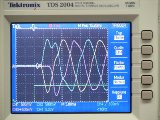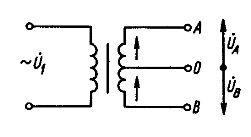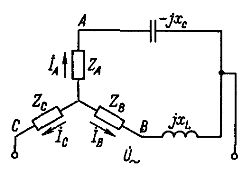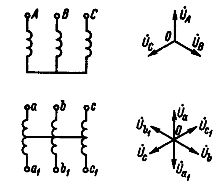Conversion of single-phase and three-phase systems
 In some cases, it is necessary to convert AC systems with one number of phases to systems with a different number of phases, as well as to perform other conversions.
In some cases, it is necessary to convert AC systems with one number of phases to systems with a different number of phases, as well as to perform other conversions.
The transformation of balanced systems into balanced or unbalanced systems into unbalanced is relatively simple. When you convert an unbalanced system to a balanced system or vice versa, capacitors or inductors or both are introduced into the system.
During periods of time when the power of the system exceeds the average, the excess power is stored in a capacitor or inductor, and when the power is less than the average, it is returned to the system.
An example of a scheme for converting an unbalanced single-phase system into an unbalanced two-phase system is shown in Fig. 1.
Rice. 1. Scheme for conversion to a two-phase system
Secondary winding single phase transformer divided into two equal halves. In one half of the coil the EMF acts, let's say, from 0 to A, and in the other from B to 0.If we consider the direction of the EMF from the beginning of the winding to the end as positive, then we get a two-phase system, the EMF of the halves of the winding of which is phase-shifted relative to each other by an angle π (Fig. 1).
A single-phase system can be converted to a balanced system. An example of a scheme for converting a single-phase system into a three-phase system is shown in Fig. 2.
Rice. 2. Scheme for converting a single-phase system into a balanced three-phase system
Additional reactions xc and xl were chosen so that the modules Za — jx° С and + jхl were the same (and equal to the module Zc, and the arguments were equal — π/ 3 and π/ 3 respectively. In this case, we get a three-phase symmetrical system of currents AzA, AzBanda integrated circuit and the corresponding three-phase symmetrical voltage system.
The conversion of a single-phase system into any multi-phase system can be done using various electronic and electromechanical devices. For example, we can get the required polyphase system from a polyphase electric generator that is driven by a single-phase motor. The deficit and excess power in this case are covered by changes in the kinetic energy of the rotating engine.
Three-phase AC converters are most widely used in multiphase AC systems. Polyphase systems with six, twelve, and more phases are used to power rectifiers, variable speed drives, and other purposes.
A diagram of the simplest six-phase converter is shown in fig. 3.
Rice. 3. Vector diagrams and a diagram of the transformation of a three-phase system into a six-phase system
The primary winding of the transformer is fed from a three-phase power source.Each of the three secondary windings has leads from their midpoints. The leads from the middle of the secondary windings are connected together.
Basically, on the side of the secondary windings, we get a six-phase symmetrical system of voltages, forming a six-ray star and displaced relative to each other by an angle of π / 3 (Fig. 3).
To obtain systems with a large number of phases, an additional EMF must be introduced to provide the necessary phase voltage changes.
Other systems can also be obtained by transformation, for example a system of two voltages shifted relative to each other by an angle of π / 2.



